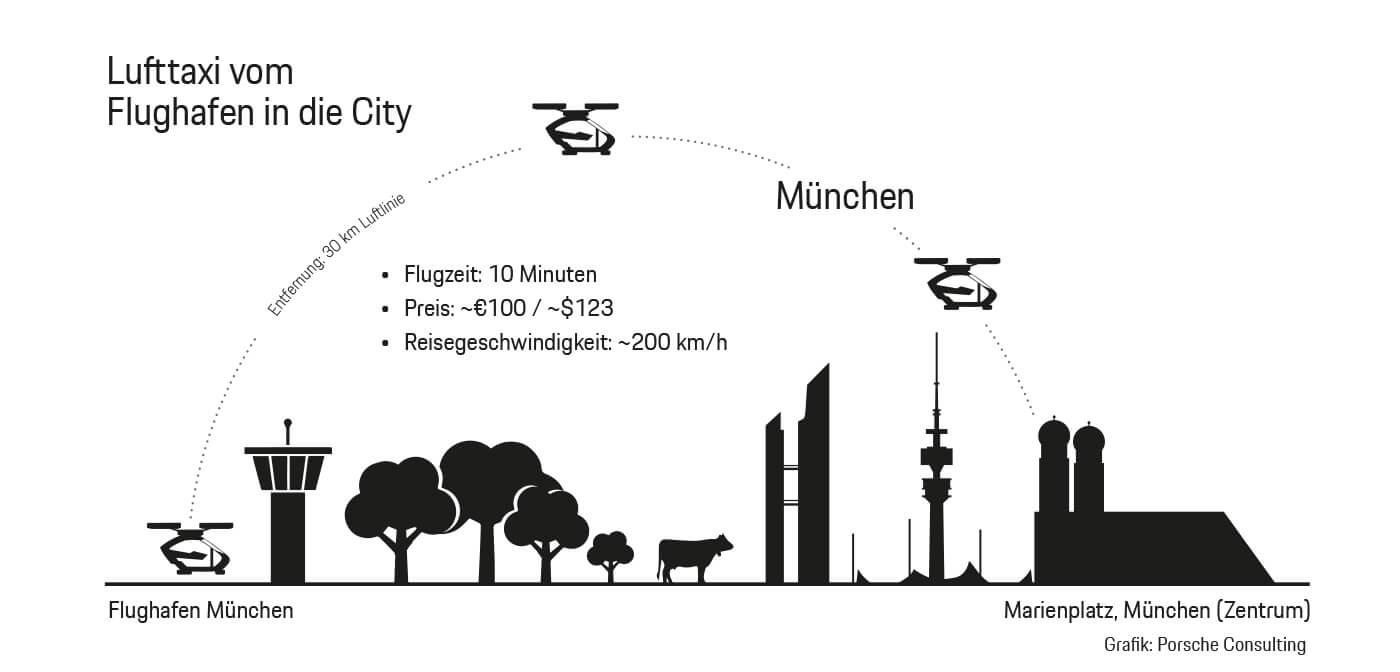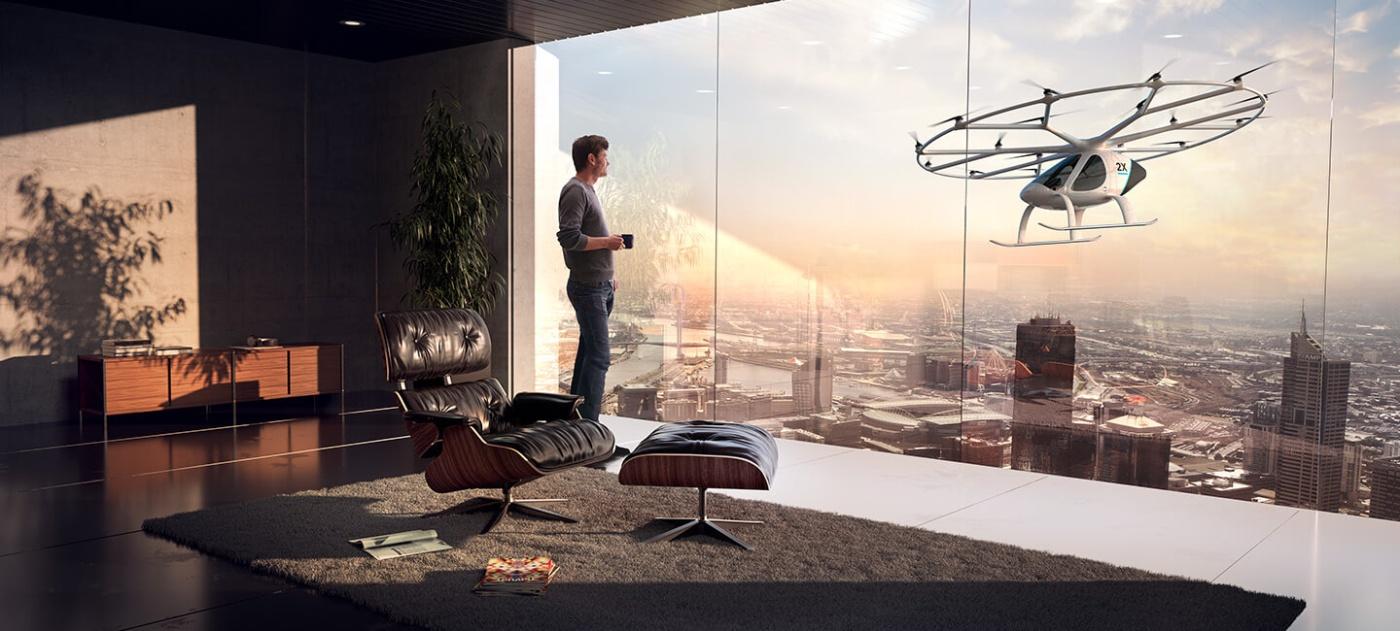
Urban Mobility
Passenger drones are ready for take-off
Why not swap traffic queues, signals, and detours for a breath-taking view? Electric or hydrogen-powered drones for short trips are poised to add a third dimension to individual mobility. Photo: © Volocopter
Until now, passenger drones have been part of the special effects repertoire of many science fiction movies. But the creatives working on them will soon have to come up with another idea. Around the world, competition is raging to build the first series-ready flying object suitable for carrying passengers over short distances. The pioneering spirit is reminiscent of an age more than 100 years ago. Back then Otto Lilienthal, the Wright brothers and other inventors were making their initial attempts at manned flight over lumpy fields and meadows. Many people simply laughed at them. At around 1900 the idea of powered flight appeared too visionary. In December 1903 the first flights by the Wright brothers’ biplane lasted just a few seconds. Five years later, its successors stayed airborne for up to two hours. In summer 1909 the Frenchman Louis Blériot became the first person cross the English Channel in a plane, flying from Calais to Dover at an altitude of 100 meters. Nowadays we regard flying between cities, countries and continents as completely normal.
Urban transport is now also about to undergo a minor revolution. Because megacities in particular are reaching the limits of their infrastructure, the individual mobility of the future is taking a new direction – skyward. Air taxis can supplement conventional services and create a new dimension in mobility, for instance by collecting passengers and bringing them to mobility hubs and airports. Around the globe, various approaches are competing. There are around 100 air taxi projects in the world. Many of these designs are less inspired by cars than by helicopters and drones. Some companies are indeed working on hybrids that will be able to travel on the roads and then extend wings so they can take to the air. However, today’s promising prototypes are based on rotors and VTOL. VTOL stands for “vertical take-off and landing” and its advantage is that whereas airplanes need long runways, drones can take off and land almost anywhere – on high-rise buildings, on parking lots or right next to intersections. All they need is 100 square meters of space.
Zero emissions and autonomous
What do the new concepts have in common? They use electric motors to achieve quiet, zero-emission mobility. This makes them lighter and smaller than helicopters – not to mention the way they operate and their technical complexity. Although the first air taxis will initially have pilots on board, we can expect computers to take over relatively quickly. Passengers will be able to simply climb in, indicate their destination using an app or a language assistant, and off they’ll go. In fact the air is even more suitable than the roads for the revolution in autonomous flight. Above the rooftops, the traffic situation the software has to gradually learn is less complicated – without so many other modes of transport, parked cars, children playing by the roadside, regional regulations or chaotic intersections. Recognition of and action to avoid other flying objects and tall buildings must work without a hitch. Several sensors and camera and radar systems provide all-round scanning of the immediate vicinity to detect potential obstacles and initiate a change of direction to avoid hazards. Today’s autopilot systems in aircraft already demonstrate that it is possible to travel safely without human control. However, approvals and certification tests still have to be drawn up. But it is not all that straightforward to implement an air-traffic control system monitoring air taxis and traditional aviation. The US Federal Aviation Administration (FAA) and the European Union Aviation Safety Agency (EASA), for example, are still working on the issues involved.
Market potential of passenger drones
In the first six months of 2020, over 900 million US dollars were poured into the sector – despite coronavirus and the crisis in aviation. It will be exciting to see how the market develops in 2022 and thereafter, because the pandemic is grounding the fleets, airports are deserted and the airspace is empty, and airlines and the entire industry are worried about their survival. Yet a study by Roland Berger still sees the trend as positive. It predicts that by 2050, up to 160,000 commercial air taxis will be deployed and the industry will be turning over almost 90 billion US dollars a year. The total distance covered by passenger-carrying drones will then come to an annual 18,800 million kilometers. The study’s authors foresee the greatest demand for city taxis, accounting for 36 percent, and for airport shuttles on 35 percent. Yet not only the manufacturers of air taxis will get a slice of the pie. A whole ecosystem is springing up around the new form of mobility, which is spawning a number of different business models, for instance the operation of landing sites, maintenance and repairs, and digital services surrounding flights.

In the near future, smart connections between modern traffic systems could relieve the pressure on critical hubs and liberate people from stress, wasted time and environmental problems. Flying taxis represent one component in the mobility of tomorrow.Gregor GrandlSenior Partner at Porsche Consulting
Porsche Consulting has also published a study of the potential of the “urban air mobility” market. The experts forecast that by 2035, there will be 23,000 flying taxis serving cities and the market will be worth 33 billion US dollars. They calculated that the flight time from Munich Airport to the city center would be reduced to ten minutes and the fare would be 100 euros per person. Doing the same trip in a conventional taxi costs around 70 euros. In Hamburg it’s only ten kilometers from the airport to the heart of the city and the study estimates the price of a one-way air trip taking three minutes at 35 euros. Scientists at the Technical University of Munich, the Technische Hochschule Ingolstadt and Bauhaus Luftfahrt are not quite so optimistic. A feasibility study conducted for Bavaria concluded that flying taxis will not have any significant impact on our traffic. On routes shorter than ten kilometers, passenger drones would probably not account for more than 0.05 percent of the daily mileages. Only on longer routes (40 to 100 km) would they reach a share of 3 percent or more. So the authors don’t expect them to become more than a niche market. Furthermore, VTOL aircraft would not be replacing any other form of transport. To offer fares similar to those of taxis, the operators would have to achieve a high level of capacity utilization and offer a very large number of seats. The challenges are familiar from traditional aviation. A breakthrough by flying taxis would depend not only on the price and the technology, but above all on the confidence of the future passengers. This always has to be the main focus of development.

A new industry is born
Both startups and large, well-known companies are working on new designs (often in cooperative projects) and the first test flights have already taken place. The German company Volocopter is forging ahead in the development of new individual flying concepts. Its aircraft resembles a helicopter in shape. It has skids, a cabin for two people, and 18 small rotors mounted on a circular frame. Nine rechargeable batteries power the rotors. And because the rotors generate sound within a narrow frequency band, humans perceive them as only about twice as loud as a single rotor. This means that a Volocopter closer than 100 meters is as quiet as a small helicopter with a main rotor, a tail rotor and a turbine 500 meters away. With a range of 35 kilometers per trip, it could operate in any megacity. Redundancies and ultra-modern flight “assistants” ensure safety. Its top speed is 110 km/h. After over 1,000 test flights and almost ten years amassing experience, the Volocopter is one of the most highly developed flying taxis in the world. The first commercial passenger flights on inner-city routes are scheduled to start in 2022. The Bavarian startup Lilium is working on a cross between a jet and a drone – the Lilium Jet – with room for five passengers. It is propelled by 36 tilting integrated jets mounted on its wings. The electrically powered aircraft will be able to take off vertically and turn the propellers into a horizontal position while airborne, so that it can zoom away like a normal light aircraft. However, the design is more focused on connecting cities, suburbs and the surrounding villages.

New gold rush: large and small battle for the skies
Airbus and Boeing, the two giants of aviation, are also in on the act. Airbus’ “Vahana” flying taxi was fully electric. The project was terminated at the end of 2019, after four years of development. Now Airbus is concentrating on its four-seater “CityAirbus” multicopter that has a cabin just like a small helicopter and four noticeably large rings above it housing the rotors. Competitor Boeing is developing a design for an all-electric VTOL aircraft in cooperation with Porsche since 2019. With its pointed wings the aircraft resembles the famous Batmobile. Some design elements are reminiscent of Porsche's. At the beginning of 2020 Toyota invested roughly 350 million euros in the startup Joby Aviation. The aircraft is expected to have a top speed of 320 km/h and a range of 240 kilometers on a single battery charge. The mobility service provider Uber is also working with Hyundai on its own design. The company sees the concept mainly as a new option for taxi and sharing services booked using an app. The partners presented a flying taxi named “S-A1” at the CES (Consumer Electronics Show) 2020.
With the prices of drones probably running into six figures, on-demand services may actually get the services airborne. Hyundai is also positioning itself as a system provider. Its flying taxi lands on the extendible roof of a mobility hub that can be individually adapted and has any number of possible configurations, for example a medical complex with a clinic, doctor’s office and pharmacy, where the S-A1 brings patients directly to the doctor. Purpose-built vehicles on the ground will transport people and goods onward, toward their final destination. The benchmark for all market participants is Ehang from China. The company is regarded as the leading manufacturer. Dozens of “Ehang 184” and “Ehang 216” passenger drones have already been produced and supplied to customers. Thousands of manned and unmanned test flights have taken place – even under adverse weather conditions and at night – and testify to the fleet’s airworthiness. In China they are being used initially for courier services, fighting fires in high-rise buildings, and – coming soon – for tourist flights.
Vertical take-off with hydrogen
The Israeli flying taxi developer Urban Aeronautics plans to use fuel-cells in its “CityHawk” eVTOL air taxi. The technology is expected to have three times the power and four times the service life of conventional fuel cells. To this end, the company is cooperating with the Californian startup HyPoint. A prototype was already taken to the air in summer 2018 – but not powered by fuel cells. The CityHawk has no wings or external propellers. Instead, the propellers are integrated into the bodywork in front of and behind the passenger compartment. At present, Urban Aeronautics is still using a hybrid drive. The developers say the switch to fuel cells is a necessary move. The unusual design renders the CityHawk’s energy consumption much higher than that of other flying taxis. The elongated shape provides too little lift, requiring more power to compensate. Apparently the current lithium-ion motors would (yet) run out of power too soon – teething troubles familiar from the early days of electric cars.
